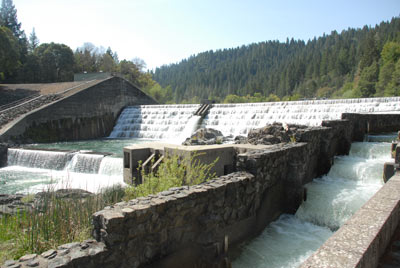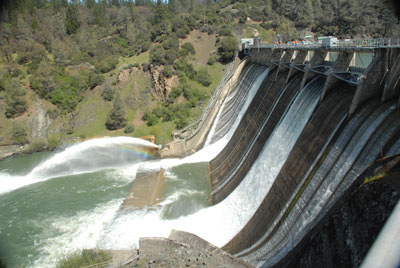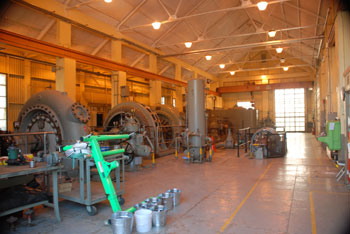The Potter Valley Project

Cape Horn Dam at Van Arsdale Reservoir, May 2008
The northern edge of Potter Valley separates the Russian River watershed from the Eel River watershed. The Eel River at this point is 475 feet higher in elevation than the headwaters of the Russian, and the hills are relatively narrow. In 1900, it was an ideal place to build a hydroelectric power plant.
The Project consists of Cape Horn Dam, a concrete gravity and earth filled structure, backed up the Eel River to form a small reservoir called Van Arsdale. This reservoir serves as the forebay for the diversion tunnel. From here, an 8' diameter tunnel, lined with redwood timbers, was dug over a mile long south through the mountain, finally opening into the north end of Potter Valley, where water flows through a penstock dropping over 450 vertical feet into the Potter Valley Powerhouse. As the project continued it required more capital investments and the Eel River Power and Irrigation Company was reorganized as the Snow Mountain Water and Power Company in 1906.
Work was stopped for a period of time after the great quake of 1906 when the crews were needed to help in San Francisco. Finally, April 1, 1908, the project began to produce power. The first two units in operation were each 2,000 kilovolt-ampere. In 1910 the power company added a 3,000 kva unit. In 1912 a second penstock was constructed. In 1917 a final 2,000 kva unit was installed and the total capacity of the powerhouse grew to 9,400 kva (9.4 megawatts).

Scott Dam at Lake Pillsbury
The Potter Valley Powerhouse was a boon to the Ukiah area with only one small downfall. The powerhouse only ran at capacity after late fall rains and into spring because the Eel River, like most of our north coast rivers, naturally gets drier and drier as the late spring rains end and summer begins. In the summer, there was not enough water in the river to run the powerhouse! Early on, in 1908, a plan was studied to build a reservoir near Gravelly Valley, twelve miles upriver from Van Arsdale, to store winter runoff and release the stored water to produce power in the summer. The first attempt to build the dam was abandoned. However, Snow Mountain Water and Power Company began the application process for a power permit again in 1918. By 1920 they acquired a Department of Agriculture Power permit to build a dam. Construction of Scott Dam, a cyclopean concrete ogee gravity structure, began right away in 1920. The Federal Power Commission (precursor to the Federal Energy Regulatory Commission (FERC) which now licenses the Project) granted a 50 year license for the project on April 15, 1922. Scott Dam was completed, and Lake Pillsbury began to fill, in 1922. Scott Dam and Lake Pillsbury were named after two of the principal investors in the project. In 1930 Pacific Gas and Electric Company (PG&E) acquired the Project from Snow Mountain Water and Power and assumed the license.
Lake Pillsbury Facts & Figures
The watershed above Scott Dam is 289 square miles, roughly 7.3% of the Eel River's total 3,971 square mile watershed. Originally the lake's capacity was 94,863 acre feet. Today, after sedimentation, the lake capacity was recently (2006) measured by the PG&E to be 74,993 acre feet when the lake is full to the top of the spillway gates. The dam's spill crest is 1,900 feet elevation. A series of radial and slide gates brings the possible storage height to 1,910, but the California State Division of Dam Safety requires the storage levels to be maintained at very precise levels based on time of year, forecast storms and snow pack. The spillway capacity of Scott Dam is 66,000 cubic feet per second (cfs). (the spillway capacity at Cape Horn Dam is 109,000 cfs). Lake Pillsbury is a relatively shallow lake with a surface area of about 2,280 acres. In a wet winter the capacity of the lake can be filled and spilled as many as 8-9 times.

Potter Valley Powerhouse
The value of the Project for power production is not insignificant in a world where green, renewable power is valued. Nine megawatts is enough to power the nearby city of Ukiah with locally, sustainably produced electricity. The value of the Project for water supply is nearly immeasurable. The quality of life for over 500,000 people who live in the communities and cities downriver from Potter Valley has evolved and improved with the existence of the water from the Project for over 100 years. Agriculture, the lifeblood of the economy of Mendocino County, thrives with the existence of this water. Recreation at Lake Mendocino, and down the Russian River, is dependent upon the Project. A community has grown near the shores of Lake Pillsbury and the economic value of this community and recreation in Lake County is important to their economy as well. The water from the Project is also released from storage in Lake Mendocino and used to enhance spawning migration flows for endangered salmonids in the Russian River. A riverine ecology, and the economy of Mendocino and Sonoma Counties, has evolved with the existence of the Potter Valley Project diversion for over the past 100 years.
